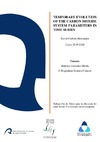Please use this identifier to cite or link to this item:
https://accedacris.ulpgc.es/jspui/handle/10553/74343
| Title: | Temporary evolution of the carbon dioxide system parameters in time series | Authors: | Curbelo Hernández, David | Director: | González Dávila, Melchor Santana Casiano, Juana Magdalena |
UNESCO Clasification: | 251002 Oceanografía química | Keywords: | Air-sea CO2 exchange Northeast Atlantic Northwest African coastal upwelling |
Issue Date: | 2020 | Abstract: | Oceans are important CO2 sinks that buffer the increase in their atmospheric concentration derived from anthropogenic emissions, which has produced alterations, not only in the Earth's climate, but also in marine biogeochemistry. One of the largest and most important ocean sinks, and therefore one of the most susceptible to disturbances, is the North Atlantic, so the study of the CO2 system in this basin is essential to understand and know to confront the Global Change. This work has focused on the study of the seasonal variability of the CO2 system and the air-sea CO2 exchange based on data collected by a volunteer observing ship (VOS) in the Northeast Atlantic, in a region of interest between the Northwest African coastal upwelling and the oligotrophic waters of the North Atlantic subtropical gyre between the Canary Islands and the Strait of Gibraltar (~28-36ºN). The results show the seasonal and spatial variability of the air-sea CO2 fluxes in this region, mainly driven by variations in CO2 solubility in seawater controlled by temperature. The system behaves as a source in summer with maximum average CO2 fluxes around 2 mmol m-2 d -1 in oceanic waters of the Canary archipelago (2,147 ± 0.262 and 1,992 ± 0.358 mmol m-2 d -1 on the routes between Gran Canaria and Tenerife and between Tenerife and Lanzarote respectively); and as a strong sink in the cold months, with minimum average CO2 fluxes around -3 mmol m-2 d -1 during winter throughout the study region. Moreover, the average of fCO2 is in the range between ~420 µatm in summer and ~370 µatm in winter in all routes, observing some longitudinal variability in inter-island routes and in the Strait of Gibraltar associated with hydrographic differences. An evident latitudinal variability along the African coast was related to regional differences in the intensity of the coastal upwelling that explain the minimum values of fCO2 and FCO2 determined in the region closest to Cape Ghir and in the Strait of Gibraltar, where the system has behaved as a CO2 sink in all seasons of the year. Finally, it was determined in this work an average CO2 flux of -4.78 ± 0.6 Tg year-1 , which indicates that this area of the Northeast Atlantic behaves as a net CO2 sink. | Department: | Departamento de Química | Faculty: | Facultad de Ciencias del Mar | Degree: | Máster Universitario en Oceanografía por la Universidad de Cádiz, la Universidad de Las Palmas de Gran Canaria y la Universidad de Vigo | URI: | https://accedacris.ulpgc.es/handle/10553/74343 |
| Appears in Collections: | Trabajo final de máster Restringido ULPGC |
En el caso de que no encuentre el documento puede ser debido a que el centro o las/os autoras/es no autorizan su publicación. Si tiene verdadero interés en el contenido del mismo, puede dirigirse al director/a o directores/as del trabajo cuyos datos encontrará más arriba.
Show full item recordPage view(s)
172
checked on Nov 9, 2024
Download(s)
46
checked on Nov 9, 2024
Google ScholarTM
Check
Share
Export metadata
Items in accedaCRIS are protected by copyright, with all rights reserved, unless otherwise indicated.
